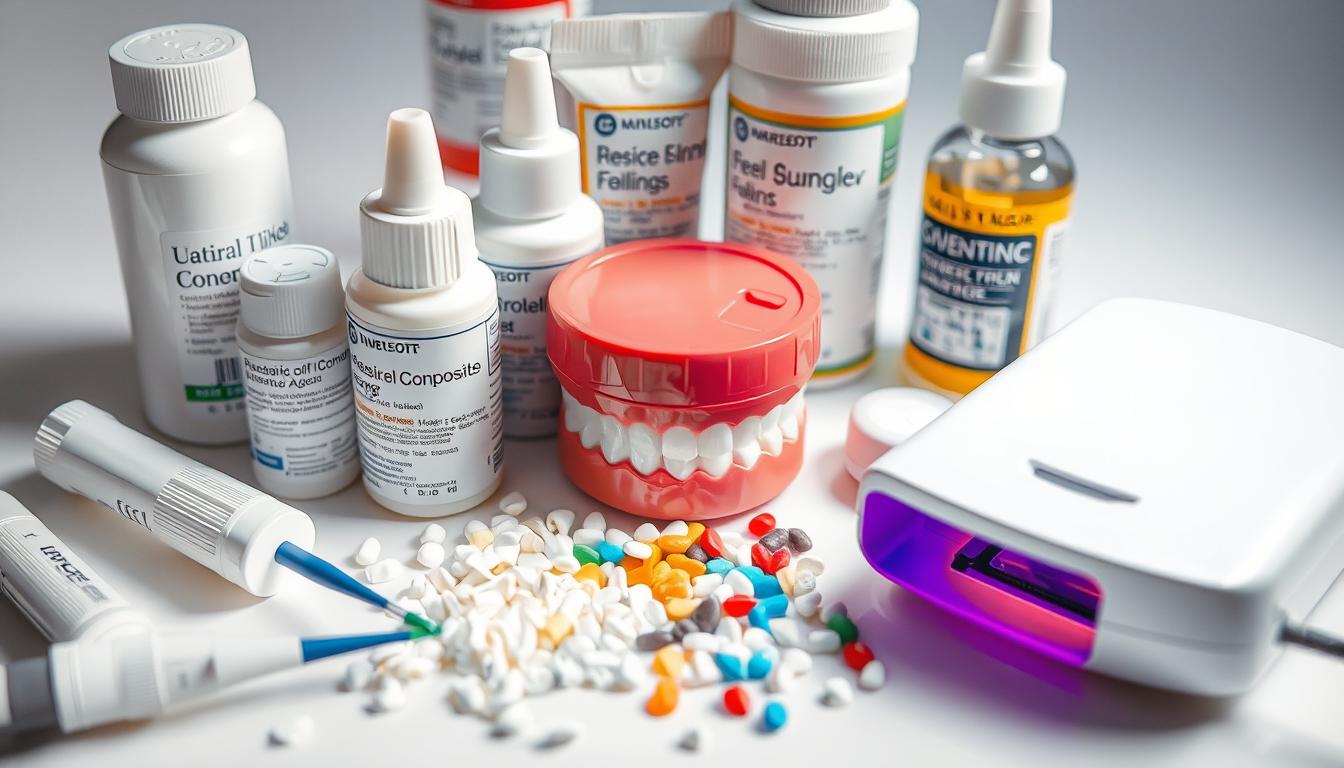What Are Composite Fillings Made Of?

When you smile, nearly 92% of people notice your teeth first. Many don’t realize that science is key to keeping that smile bright. Composite fillings, also known as composite resin fillings, are complex compounds. They play a major role in dental restoration. This article explains the advanced materials that make composite fillings look natural while offering strong restoration.
Among various dental restorations, composite dental restorations are unique. They match the natural color of teeth well. The main part of composite fillings composition is a plastic (acrylic) resin base. It’s made stronger with finely powdered glass. This mix creates restorations that are strong yet discreet. An exploration of dental resin fillings ingredients shows how science and beauty come together to improve dental health and appearance.
As the demand for metal-free dental restorations grows, not only doctors but also informed patients take an interest. They want to understand what their treatments are made of and their advantages. Knowing the components and benefits of composite fillings composition is crucial. It helps anyone looking to maintain or improve the durability and success of their dental work.
Key Takeaways
- The primary ingredient in composite fillings is a plastic (acrylic) resin.
- Composite fillings include powdered glass to enhance strength and mimic the natural tooth appearance.
- Compatibility with the natural color of teeth makes composite fillings a preferred choice for visible dental restorations.
- Medical professionals and patients alike should be informed about the dental resin fillings ingredients for optimal care decisions.
- Composite fillings are a testament to how advancements in materials science contribute to dental health and aesthetics.
Introduction to Composite Fillings
Composite fillings match the look of your natural teeth. They are key in fixing cavities and are also used in making your smile better through procedures like veneers and crowns. These tooth-colored fillings materials are a big step forward in dental repair work.
What makes up composite fillings? They have a special mix of acrylic resin and fine glass. This mix not only looks like your real teeth but is also strong and durable for daily use.
But composite fillings do more than just fix cavities. They fix chipped, broken, or worn teeth too. They blend in with your teeth, unlike gold or amalgam fillings, which are easy to see and not as nice looking for teeth that show. This makes them a better choice for front teeth.
Let’s look at what’s in composite fillings compared to old-school amalgam fillings:
| Material | Benefits | Common Uses |
|---|---|---|
| Composite (Acrylic resin and glass particles) | Aesthetic appeal, bonds directly to tooth structure, less tooth removal required | Cavities, chipped or broken teeth, cosmetic enhancements |
| Amalgam (Silver and mercury) | Durability, cost-effectiveness | Large cavities in back teeth, situations requiring durable fillings |
tooth-colored fillings materials like composite fillings have a vital role. They make your teeth look natural while fixing and improving them. This is why they’re a popular choice.
The Main Components of Composite Fillings
In the world of dentistry, how dental materials work and look is very important. Talking about what’s inside composite fillings, we see a mix of parts that work well and look good with real teeth.
Resin Matrix
At the base of composite fillings is a resin matrix, made from something called bisphenol A-glycidyl methacrylate, or Bowen’s resin. This matrix sticks the fillers together and makes sure the filling fits right with the tooth.
Glass or Ceramic Fillers
Another key part of composite fillings is the glass or ceramic fillers. These fillers, mostly silicon dioxide, make the composite strong and able to resist wear. Their tiny milled particles help make the composite last longer, even when you’re chewing.
Coupling Agents
Coupling agents are really important for making the resin and the glass fillers stick together better. These agents, usually called silanes, spread out the stress, helping the filling last longer when you bite and chew.
Pigments
The reason composite fillings look so good is because of pigments. The pigments are chosen to match your teeth, making fillings blend in. This makes sure fillings can’t be spotted against your natural teeth.
Every part of the resin-based composite fillings is chosen with care to act like real tooth enamel and dentin. Knowing what’s in these fillings helps us see how they fix, last, and look great in your mouth.
The Role of Resin in Composite Fillings
In dental work, the resin is crucial. It acts as the base for composite fillings, mixing all the needed elements. This is often called Bowen’s resin. It’s super important for it to work right, changing from soft to hard, just like tooth enamel, during the curing process.

How well composite fillings work depends a lot on the resin quality. It wraps around and sticks to the tooth. This ensures a smooth mix with the tooth, keeping its look while stopping decay or looseness. A special blue light makes the resin harden and stick well to the tooth.
The resin does more than just stick things together. It helps fillings last longer and stay strong. For those wanting their teeth to look and work naturally, the right mix in the resin is key. It balances everything in the filling.
K
kKnowing how resin works in fillings helps doctors and patients understand the science behind dental care. It shows the need for ongoing research in dental materials.
Importance of Fillers in Composite Materials
Fillers do more than just fill space in dental resin fillings. They improve the strength and durability of the fillings. This section talks about the various fillers used in dental resin fillings. We’ll see how these fillers make the fillings last longer and work better.
Types of Fillers
Different fillers add strength and look good in dental resin fillings. We often use silica, zirconia, and glass ceramic particles. Thanks to progress in dental materials, we now have nano-sized fillers. They give a smoother finish and better polish than older fillers.
Effects on Durability
Fillers play a big part in how long composite fillings last. By picking the right fillers, makers can create fillings that look natural and resist wear well. A higher amount of filler makes the filling tougher and less likely to shrink. This is why fillers are so important for the lifespan of dental resin fillings.
Enhanced durability and improved aesthetic outcomes are key drivers behind the innovations in filler technology for dental composites.
The table below highlights the commonly used fillers and their specific impacts on the properties of dental composites:
| Filler Type | Particle Size | Impact on Composite |
|---|---|---|
| Silica | 20-50 nm | Increases translucency and hardness |
| Zirconia | 100-200 nm | Enhances fracture toughness |
| Glass Ceramic | 0.5-1 µm | Improves wear resistance and aesthetic appeal |
| Nano Filler | 5-75 nm | Reduces polymerization shrinkage; enhances polish retention |
Benefits of Using Composite Fillings
Composite fillings are becoming more popular in dentistry because of their great benefits. These benefits include looking better, bonding well, and being used in many ways. Let’s look at how composite fillings benefits lead to improved dental care for everyone.
Aesthetic Appeal: Composite fillings’ biggest perk is they look like your real teeth. They tooth-colored fillings materials blend in, especially on front teeth or where the tooth shows when you smile. So, no one can tell there’s a filling.
Bonding Strength: Not only do they look good, but composite fillings are also strong. They bond to your tooth, supporting it and stopping breaks or damage. This strong bond reduces the chance of leaks, a common issue with other fillings.
Versatility: Another plus is their ability to fix not just cavities but also chips, breaks, or wear on teeth. Their flexibility makes them a top choice for many types of dental repairs. They really are helpful for lots of dental problems.
The mix of these composite fillings benefits and the improvements in tooth-colored fillings materials are why they’re a top choice for dental work. They offer both function and looks, meeting the needs of patients perfectly.
How Composite Fillings are Made
The process of making composite fillings is detailed and high-tech. It includes many steps to make sure the fillings work well and look good. Learning about this process shows the careful work that goes into fixing teeth and making them look nice again.
Mixing the Components
First, dentists mix certain materials together. They combine a resin with glass or ceramic and some color. This mix looks like natural teeth but is also strong and lasts long. The aim is to get a mixture that’s easy to apply but still looks good.
Application Process
Next, the mixed material gets put on the tooth that needs fixing. Dentists add it layer by layer, making sure each part sticks well before adding more. This careful layering helps the filling stay strong and look just like the other teeth.
Curing Techniques
A special light then cures, or hardens, each layer of the composite. This step uses a curing light that makes the material firm and stick to the tooth well. It makes sure the filling lasts a long time and works well.
At the end, the composite filling looks like a real tooth and can handle chewing and biting. Every step, from mixing to hardening, is done with great care. This makes sure the filling lasts long and does its job.
Dentists do this work very carefully, keeping the patient comfortable the whole time. New tools and materials have made composite fillings better and more popular for fixing teeth.
Differences Between Composite and Other Filling Materials
Choosing the best filling material is vital for dental health and looks. We’ll look at how composite fillings differ from amalgam, glass ionomer, and porcelain. You’ll see why composites are often the top pick for cosmetic dentistry.
Amalgam Fillings
Amalgam fillings are strong and budget-friendly. But, they have mercury, leading to safety and environmental worries. Compared to composite vs amalgam fillings, amalgams don’t match your tooth’s color well. This makes them less fitting for teeth you see when smiling.
Glass Ionomer Fillings
Glass ionomer fillings help stop decay by releasing fluoride. Yet, they’re not as strong or long-lasting as dental restorations materials like composites. They work best on teeth that don’t bear chewing pressure or as temporary solutions.
Porcelain Fillings
Porcelain fillings look great and are tougher than glass ionomers. But, getting them takes more dentist visits. While they mimic your natural teeth color well, they’re also pricier than composites.
| Material | Aesthetics | Durability | Cost |
|---|---|---|---|
| Composite | Excellent – Natural Look | Good – Durable with proper care | Moderate |
| Amalgam | Poor – Metallic finish | Very High – Highly durable | Low |
| Glass Ionomer | Good – Subtly blends | Low – Less durable | Low |
| Porcelain | Excellent – Highly aesthetic | High – Resistant to wear | High |
In the end, choosing between composite vs amalgam fillings and other materials depends on several things. Think about where the filling goes, your budget, how you want it to look, and dental health over time. With new dental tech, composites are a trusted, popular choice for many dental restorations materials.
Longevity of Composite Fillings
People often ask, “How long do composite fillings last?” This question is key to knowing their worth in fixing teeth. These fillings usually last between 7 to 10 years. But, with great care, they can last even longer. The life of these fillings depends on their size, where they are in the mouth, and how well a person takes care of their teeth.
New improvements in dental tech have made composite fillings last longer. Now, they’re not just good-looking but strong too. Their long life comes from not just the materials used but also how well they’re put in and looked after.
| Factors Impacting Durability | Typical Effect |
|---|---|
| Extent of Decay | More extensive decay requires larger fillings, which may reduce lifespan. |
| Filling Size | Larger fillings endure more stress, potentially shortening longevity. |
| Patient’s Dental Hygiene | Better hygiene practices can extend the life of fillings. |
| Location of Filling | Fillings in high-bite force areas, like molars, may wear out faster. |
Knowing how long composite fillings last also means knowing they might need upkeep. They could need fixes or to be replaced due to wear or changes in the mouth. Yet, with routine dentist visits and good daily care, these fillings might last over a decade.
Factors Influencing the Lifespan of Composite Fillings
The life of composite fillings in our teeth relies on many things, such as how well we take care of our teeth and our daily habits. By knowing what affects these fillings and taking good care of them, we can make them last longer.
Maintenance of the dental resin fillings is key. It keeps them looking good and working right. Brushing and flossing well are important to get rid of stuff that could harm the fillings. The materials in the fillings are made to last, but they need the right care to keep their shape and look.
- Oral Hygiene: Good oral hygiene is a must. This means brushing twice a day with fluoride toothpaste, flossing every day, and using a mouthwash that fights germs. This helps prevent plaque that can damage the fillings.
- Diet and Habits: What we eat and do affects our fillings. Acidic or sugary foods can wear down or stain the fillings. Bad habits like teeth grinding or using our teeth to open things can also harm fillings.
In conclusion, we can make composite fillings last longer with proper care and changing some habits. Sticking to a good dental care routine and avoiding things that can damage fillings are key steps to keep them in good shape for years.
Maintenance of Composite Fillings
It’s very important for both patients and dental experts to properly care for dental bonding. They must pay careful attention to the bonding’s composite materials. They should also keep up with routines that support the fillings’ strength and looks.
Visiting the dentist regularly is key. At these check-ups, they can check on the fillings and gums. Catching any problems early means they can be fixed quickly. This helps the fillings last longer and stay looking good.
At-Home Care Tips
- Stay away from rough toothpastes that might scratch the composite. Choose a soft, gel-based toothpaste instead.
- Make sure to brush twice a day and floss often. Removing plaque around the fillings stops stains and decay.
- Try to eat less foods and drinks that stain like coffee, red wine, and avoid tobacco. Over time, composite can pick up colors, making them look less attractive.
Adding these steps to your daily routine can really help keep your dental work in top shape. This means your composite fillings will work well and look beautiful for a long time.
Common FAQs About Composite Fillings
Composite fillings are becoming more popular because they look good. This part answers big questions about them. It makes it easier to understand how they work and how to look after them.
It’s key to know how long these fillings last, if they’re safe, and how to take care of them. Let’s tackle these important topics with straightforward answers.
How Long Do They Last?
Composite fillings usually last between 5 to 7 years. Their lifespan can change depending on their location in the mouth, their size, and how well you take care of your teeth. Visiting the dentist regularly and taking good care of your teeth can make them last longer.
Are They Safe?
Composite fillings are a mix of plastic and fine glass particles, and they’re safe to use. They look like natural teeth but don’t have mercury, which is in some other fillings. This makes them a safe choice for fixing teeth.
Can They Stain Over Time?
Just like your actual teeth, things like coffee, tea, wine, and smoking can stain composite fillings. But cleaning them well and avoiding these stain-causers keeps them looking good.
To sum up, composite fillings are a good-looking and safe choice for fixing teeth. But they need proper care to stay beautiful and work well. Good oral hygiene and dentist visits play a big part in keeping them in top shape.
Conclusion: Composite Fillings in Modern Dentistry
In today’s dentistry, composite fillings are vital for better patient care. They are designed to be durable, look good, and work well, making them key in oral health treatments. These fillings combine the latest dental practices with ongoing improvements in materials.
Composite fillings show the importance of sharing knowledge and improving medical science. They mix difficult medical terms with easy explanations. This highlights their importance in providing a better option than old solutions. They can be used in many dental repairs, helping dentists and patients get more personalized, effective care.
Using composite fillings is not only about fixing or replacing teeth. It’s about making someone’s life better. Our goal to improve medical science is seen in how we improve these materials and methods. As doctors and researchers work together, and patients learn more about their dental health, composite fillings will stay a top choice for dental care.


